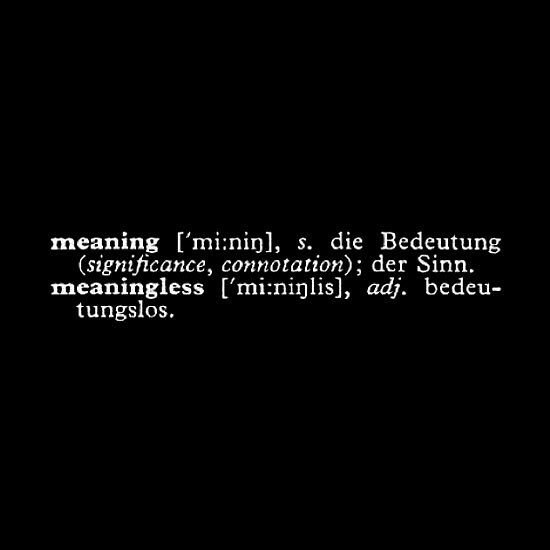Tactically, conceptualism is no doubt the strongest position of the three; for the tired nominalist can lapse into conceptualism and still allay his puritanic conscience with the reflection that he has not quite taken to eating lotus with the Platonists.
—Willard van Orman Quine1
Philosophers often add “-ism” to a term in order to highlight a distinct approach to a fundamental question, that is, to name a philosophical doctrine. For example, when it comes to universals, The Oxford Dictionary of Philosophy tells us that “Conceptualism is a doctrine in philosophy intermediate between nominalism and realism that says universals exist only within the mind and have no external or substantial reality.”2 There are other definitions, but the point about the use of “-ism” to name a philosophical doctrine is clear. For art critics, curators, and historians, however, “-isms” have somewhat different purposes: they name movements in art, broadly shared approaches that have become styles or threaten to do so. During the heroic years of the modern movement, when critics, artists, or art historians first added “-ism” to a word, they usually meant what the suffix usually means in ordinary language: that x is like y, even excessively so. Often with ridicule as their aim, they highlighted a quality twice removed from the source of that particular art, from its authenticity. Thus “Impressionism” and “Cubism,” neither of which names what is really going on in the art to which it refers: each takes up a banal misdescription and then exaggerates it into a ludicrous delusion on the part of the artists. The success of the early twentieth-century avant-gardes led to a plethora of “-isms” that gradually lost these negative connotations and become almost normal descriptors. By mid-century, anyone could generate an “-ism,” and too many artists did so in their efforts to link their unique, often quite individual ways of making art to what they, or their promoters, hoped would be market success and art historical inevitability. When Willem de Kooning, at a meeting of artists in New York in 1951, said: “It is disastrous to name ourselves,” his was a lone voice, quickly silenced by the tide that named all present Abstract Expressionists.
By the 1960s this kind of naming had become so commonplace, so obvious a move, and such a sure pathway to premature institutionalization and incorporation, that many artists rejected it, to avoid being comfortably slotted into what they regarded as an ossified history of modernist avant-gardism. In the 1970s, for example, artists driven primarily by political concerns consciously blocked efforts to designate their work as belonging to a “political art” movement. Yet for some artists, long excluded from any kind of historical recognition, this was a risk worth taking: feminist artists emphasized their feminism, for instance, precisely because it connected their practice to the broader social movement to vindicate the rights of women.
As the artists most acutely aware of the powers and the pitfalls of exactly these processes, conceptual artists refused to embrace the term “conceptualism” during the 1960s, ’70s, and ’80s. They were, however, happy to use terms such as “conceptual” for their work, because questioning the concept of art was precisely the main point of their practice. As we shall see, they foresaw that the tag “Conceptual Art” would inevitably be associated with their work, and thus tie it too closely to art that had already resolved its problems. Their goal was to keep their art (practice) problematic to themselves by keeping it at a (critical) distance from Art (as an institution). They therefore sought to prevent the precipitous labeling of their art by adopting one or both of two strategies: insist that the term “conceptual” be applied so broadly (describing any art no longer governed by a traditional medium) as to be meaningless, or so narrowly (indicating only language-based art that dealt with Art per se) as to be offensive to almost everyone.
It is a nice paradox that the term “conceptualism” came into art world existence after the advent of Conceptual art in major centers such as New York and London—most prominently and programmatically in the exhibition “Global Conceptualism: Points of Origin, 1950s–1980s” at the Queens Museum of Art in New York in 1999—mainly in order to highlight the fact that innovative, experimental art practices occurred in the Soviet Union, Japan, South America, and elsewhere prior to, at the same time as, and after the European and US initiatives that had come to seem paradigmatic, and to claim that these practices were more socially and politically engaged—and thus more relevant to their present, better models for today’s art, and, in these senses, better art—than the well-known Euro-American exemplars. I explored a variant of this idea—that conceptualism was an outcome of some artists’ increased global mobility—in my selections for the “Global Conceptualism” exhibition, and in my catalogue essay, “Peripheries in Motion: Conceptualism and Conceptual Art in Australia and New Zealand.”3 Retrospection of this kind has also shone spotlights on what were once regarded as minor movements in Euro-American art (Fluxus, for example).
The question posed by the exhibition “Traffic: Conceptual Art in Canada 1965–1980,” presented at the University of Toronto Art Galleries in 2010, is whether a similar valuing structure might be applied to certain strands in art made in Canada from the 1960s to the present. Even though Canadian artists were conspicuously absent from “Global Conceptualism,” certain artists have since been valued as contributors to the international tendency. Thus the exhibition asks us to look in more detail at work of the time made throughout the regions of Canada and consider whether perhaps this valuing can be extended to them. There is no suggestion that this art was nationalistic—on the contrary, it was everywhere based on skepticism about official national culture-construction. The implication is that regional conceptualisms existed—that is, that conceptualist developments (in the broadest sense) occurred differently in each of the distinct regions of Canada. Again, the implication is skeptical: in every case it is about regionality in transition, not a self-satisfied parochialism.
Triggered by remarks made by some of the key artists back in the day, I wish to revisit the terms “Conceptual art” and “conceptualism” as indications of what was at stake in the unraveling of late modern art during the 1960s and in art’s embrace of contemporaneity since. I will do so by asking what conceptualism was before, during, and after Conceptual art, and I will show that there were at least one, usually two, and sometimes three conceptions of conceptualism in play at each moment—and that these were in play, differently although connectedly, in various places, at each of these times.
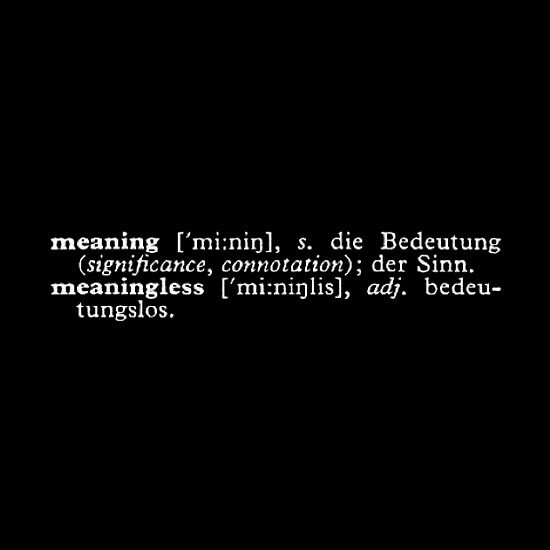

Pop or Conceptual? Or both and neither?
Let me begin with the question as seen from within orthodox art historical narratives, as a matter of the meaning of style, a concern of art historians. I start from before Conceptual art was named as a style, before the term “conceptualism” had any currency, to see what might count as Conceptual art in that circumstance.
Ian Burn, in conversation in late 1972, said of Joseph Kosuth’s Art as Idea works: “If they were made in 1965 like he claims, they are Pop Art. If they were made in 1967–8, when they were exhibited, then they are among the first conceptual works, strictly speaking.” In his 1970 essay “Conceptual Art as Art,” Burn gave these works this latter dating and characterized them as key examples of the “strict form of Conceptual Art” because they were analytic of the nature of art, their (minimal) appearance being of the most minimal relevance.4 Why did an artist with such a critical attitude toward orthodox art history’s puerile dependence on style terms apply such crude criteria to the work of a close colleague?5
Kosuth’s response was outrage at applying such anti-conceptual criteria to such work: he was an art student who had the ideas but not the resources to realize them; by the time he did have these resources a few years later, everyone (including Burn) was dating their work to the moment of conception—immediacy was the new currency.6
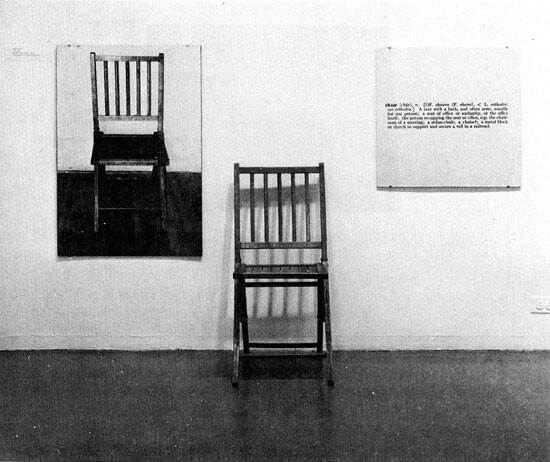

In one sense Kosuth’s One and Three Chairs (1965) is Pop-like in that its statement about what constitutes a sign is all there, all at once, and obvious, as in your face as Richard Hamilton’s 1956 collage Just what is it that makes today’s homes so different, so appealing?, but without the fascinated irony that informs the British artist’s perspective. To an observer outside the US sphere of cultural influence—or, more accurately, at its waxing and waning borders—One and Three Chairs might seem to offer viewers an open choice as to which item seems the most attractive constituent of “chairness,” thereby reducing spectatorship to supermarketlike art consumption, and artmaking to the provision of competitive goods.7 To the extent that this is true, Conceptual art that turns on overt demonstration or the instantiation of an idea (as does much of the better known and easily illustrated work—think Baldessari, Acconci, or Huebler) shares something with what might be called ordinary language Pop art, that which recycles the visual codes of consumer culture.
But the matter does not end there. In my view, the invitation to look in One and Three Chairs is at least as subtle as it is in key works on this subject by Rauschenberg, Johns, and Warhol in its conceptual questioning of what it is to see, what an image might be, what an idea looks like. These artists regularly juxtaposed photographs and objects such as actual chairs (in Rauschenberg’s Pilgrim, for example), or evoked black-and-white photography and overtly displayed the tools that made them (Johns’s Periscope (Hart Crane), 1963, for example). Warhol’s Dance Diagram (“The Lindy Tuck-In Turn-Man”), 1963, is an appropriation of an illustration, but it is also a demonstration of what constitutes a visual sign, especially when displayed, as he preferred, on the floor. Indeed, Warhol now seems the most nakedly conceptual of artists (in this pre-Conceptual art moment), precisely in his instinct for setting out one visual idea at a time, in showing an image as an idea, in making artworks that plainly demonstrated how visual ideas achieved appearance in the culture, in the visual culture, in popular imagination, in unArt, in America. The idea-image, for him, was in David Antin’s brilliant perception, a “deteriorated image.”8
There were of course many others striving to picture the many dichotomies afforded by the idea-image interplay that was taking shape at the time: a random list must include Guy Debord, with his films such as Hurlements en faveur de Sade (1952) and his collaborations with Asger Jorn; concrete poets of all kinds; Jim Dine; Kaprow, with his early happenings; Ed Ruscha; and many others, all of whom converge with Pop in certain ways, although they, like the artists mentioned above, were on a track much more interesting than that which can be encompassed by that term. In Canada, Greg Curnoe’s work throughout the 1960s offers a fascinating instance of a figurative painter, alert to the stylistics of Pop and flat color abstraction, yet, like Kurt Schwitters, drawn irresistibly to the potency of words and texts as they occur in the flow and stuff of everyday life. Add to this a Wittgensteinian consciousness that we are all products of our language-worlds, and an interesting outcome is assured. Thus, in Westing House Workers (1962), the names of a group of laborers are stamped out on a sheet that seems taken from a factory cafeteria notice board, while Row of Words on My Mind #1 (1962) stamps out a set of names of people, things, promises, and so forth, that seem as random as anyone’s everyday ruminations. By 1967, however, Curnoe had evidently seen tautology-based conceptualism (either through reproductions or via the agency of Greg Ferguson): Front Center Windows (1967) is a blue vertical rectangle stamped with black letters that describe a façade in the language of a builder’s report, while Non-Figurative Picture (1968) is a vertical column stamped with the letters of the alphabet.
These examples tell us that the question “Is it Pop or Conceptual art?” is at best a provocation (as it was for Burn), and at worst a badly formulated misunderstanding of the deeper stakes of both kinds of work. Rather, we can see that various kinds of conceptualization inspired the most inventive artists of the late modern era, and that the conceptual qualities of their work were among its most important. This is the first, the most rooted, sense in which the three ideas of what it is for art to be conceptual could count as one idea: the term “conceptual” as an adjective is most fitting to this sense. Quite properly, this basic usage precedes any real usage of the terms “conceptualism” and “Conceptual art” in art discourse, as these are derivative from it. It permits us this proposition, the first part of a proposal that I advance—with full awareness of how paradoxical a gesture it is—as “a theory of conceptualism”:
1. At its various beginnings, conceptualism was a set of practices for interrogating what it was for perceiving subjects and perceived objects to be in the world (that is, it was an inquiry into the minimal situations in which art might be possible).9
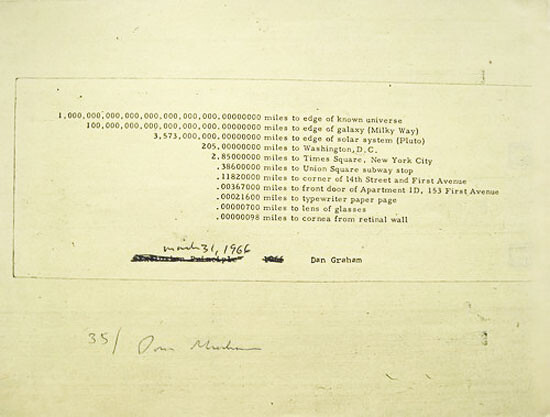

A work of art becomes consequential when it counts as art
It is lazy-mindedness to say that all art that evidently reflects on its own medium, that does so in ways unusual enough to raise the question “Is this art?,” qualifies as conceptual. There is a widespread sense, in today’s sloppy art babble, that any art that has resulted from the artist having any kind of idea is “conceptual.” Not so. You have to show that particular works, or groups of works, or a set of protocols, or a practice did these things consciously as opposed to by instinct, intelligently as distinct from intuitively, and did so effectively, with impact, with consequence.
On a number of occasions in conversation, Joseph Kosuth has pooh-poohed as pure pedantry my referencing Henry Flynt’s use of the term “Concept Art” in 1961, despite the fact that it is the first documented usage in an art context.10 “Who was this Flynt? A nobody. Who heard him, who knew of him, who cared what he said? So what if some thirteenth-century Chinese painter threw ink around in ways that look Pollock-like, or that Max Ernst did?” To Kosuth, what counts is not who said what when as a matter of plain record, or what was done in some isolated, adventitious circumstance, but whether the utterance, the work, the proposition counted in the dominant art discourse of the time. This alerts us to the internal struggle, among artists, critics, and theorists—that is, within art discourse itself—as to what was at stake in Conceptual art and conceptualism as practices of art.
Thus Kosuth’s famous statement, in “Art After Philosophy,” that “All art (after Duchamp) is conceptual (in nature) because art only exists conceptually” is not to be taken to mean that all art influenced by Duchampian strategies is conceptual, and that other art is some other kind of art. It means that only Duchampian art is truly art, and that other art is not art precisely because it does not take on the challenge of framing new propositions about art and as art.11
From this perspective, Robert Morris has a much stronger claim to consequence in works such as Card File (1962): these overtly pit the complexity of his actual life and self against the limited information contained in official descriptions of a person. Two Untitled works of 1962 (recently added to MoMA’s collection) are nothing more, but no less, than grey gouache painted over sheets of newspaper to the point of nearly obliterating the images and text. But did Morris go on with this particular line of inquiry? A short answer would be that it became one of the many lines that he has since pursued, but a longer answer is needed to do justice to such a profound oeuvre.12
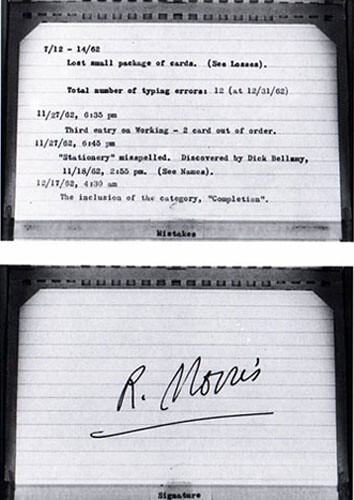

In Poland, Roman Opałka began his “infinity” paintings in 1965, sizing them to his studio doorway, beside which he has had himself photographed as each one is completed. On Kawara began traveling the world and sending daily postcards in 1959, then started making a date painting every day in 1966, and two years later embarked on the production of his One-Hundred Year Calendar that lists everyone he meets each day. Examples of such total commitment to applying a routine to a life, knowing that the two are fundamentally incompatible, abound. They may be found all over the world during this period, and are constantly being taken up nowadays by young artists (Emese Benczúr, for example). I think that we are getting close to the core of conceptualism worthy of the name, and to the basis of its appeal to serious young artists today: it is something to do with rigor, without cause, and with implacable commitment in the face of meaninglessness. So, in retrospect, it is no surprise that such a spirit should emerge from within the conflicted confusions of the mid- and later 1960s.
Sol LeWitt’s statement, in his 1967 “Paragraphs on Conceptual Art,” is famous:
In conceptual art the idea or concept is the most important aspect of the work. When an artist uses a conceptual form of art, it means that all of the planning and decisions are made beforehand and the execution is a perfunctory affair. The idea becomes a machine that makes the art.13
This seems clear to the point of being classical (indeed, the last sentence is one of the epigrams to “Art After Philosophy”). But we need to ask: what did LeWitt mean by “the idea or concept”? If one examines closely the nature of these paragraphs, as an artist’s statement—that is, if you put them back into the context of his own practice and see them as first and foremost a statement of the principles governing that practice (not all possible practice, not the practice most desired of all artists from now on)—then it becomes obvious that what LeWitt meant by an idea was a geometrical figure, and what he meant by a concept was a procedure for carrying out the realization of this idea, for example, as a singularity or as a specified sequence.
If, however, you read closely the 1969 “Sentences on Conceptual Art” [copies of the handwritten and corrected versions of 1968 have recently come to light], you are immediately thrown into the paradox just mentioned:
1. Conceptual artists are mystics rather than rationalists. They leap to conclusions that logic cannot reach.
2. Rational judgments repeat rational judgments.
3. Irrational judgments lead to new experience.
4. Formal art is essentially rational.
5. Irrational thoughts should be followed absolutely and logically.14
The contrast between rationality and mysticism is weak, and soon disappears. More important is that here we can see awareness of the reach but also the limits of ideas and concepts narrowly defined. It is their potential to create chaos, disorder, and revolution that comes to be valued, thus the peculiar poignancy of the proposals from visiting artists—to be realized by students, and, occasionally, the artists themselves—in David Askevold’s Projects Class at NSCAD from 1969 forward. The postcards of the instructions, shown in the “Traffic” exhibition, are exquisite mementoes of each artist’s unique, distinctive mode of thought. More generally, objectivity was not the point: rather, rationality had to be shown to be crazy by being enacted literally; the Organization Man was nuts, viz. General Idea, Pilot (1977).
Let us return to One and Three Chairs and see whether it meets these deeper criteria—Kosuth’s own—of what counts as conceptual. In the most immediate sense, it looks like a simple demonstration. Signified + signifier = sign. All there, all at once. A rose is a rose is a rose. But there are two signifiers, after all, which open up a space of ambiguity (which may be closed again when we read the work as an illustration of Plato’s three stages of knowledge). The project becomes more interesting when we realize that other chairs could be used under the same title, and other objects—for example, a shovel, à la Duchamp’s In Advance of the Broken Arm, an authorized replica of which is owned by Kosuth. The point is that One and Three Chairs is not a one-off, singular visual statement: it is an instantiation of a proposition that may be realized using any matching set of elements. Like many other works conceived at the time, it is an exemplification of an act of thought. Kosuth’s “Art as Idea” series seems to be a set of tautological objects: actually, they are visual propositions about themselves as signifying instances, presented as Art (or Art as Idea as Idea)—on the post–Ad Reinhardt grounds that that is all that art, in conscience, at this time, can be.15
A step forward was to take stated propositions as thesaural, which opens out their closure, their two-way tautology, as Kosuth did when he placed thesaural categories in newspapers in his Second Investigation (1968–9). In a parallel way Mel Ramsden’s Secret Painting, made in 1967 in London en route to New York, becomes a comment on the limits of painting as a practice. Such questioning could be consequential: it released artists elsewhere in the world to begin an interrogative practice. For example, Robert MacPherson in the 1970s in Brisbane deployed this strategy to appropriate ordinary language use—in his case, roadside signs. So did Greg Curnoe, in his banner paintings of the 1980s.
Propositionality—its apparently categorical force, but also its materiality and its provisionality—is what language-based conceptualism recurs to: it is its core, from which it opens out again. First this is understood spatially (sculpture is residual here), as in Dan Graham’s March 31, 1966, a description that evokes a spatial zooming beyond spatiality. (His Schema for Aspen magazine, and for the first issue of Art-Language, is his masterwork). Then it is understood as a phenomenon of perception (painting is residual here), as in Ian Burn’s No Object Implies the Existence of Any Other (1967). This is, in fact, a thought that is impossible to have in a literal sense: you cannot think the idea of an object not implying another object without thinking about at least two objects, one and an other; in front of an object made to be seen by an other (us), consisting of a statement on a mirror that cannot but show you yourself and other objects. (That is, it demonstrates the rest of Hobbes’s statement, “…that is, if we consider these objects in themselves and never look beyond the ideas that inform them.”) Yoko Ono was closer to Hobbes in her 1961 “proposal”: Painting to Let the Evening Light Go Through. Burn’s Xerox Book (1968) is more resolute: it embodies the idea of a tautological process.
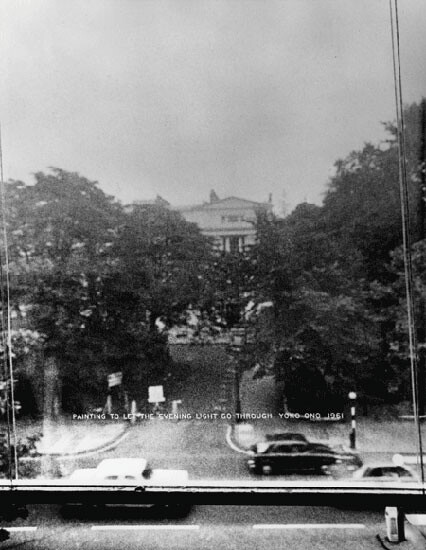

LeWitt’s 35th and last sentence read: “These sentences comment on art, but are not art.” The editorial to the first issue of Art-Language, in which these sentences appeared in 1969, asked itself the question, “What would follow [for the art community of language users] if this editorial itself came up for the count as a work of art?”
It is these innovations that allow us to recognize the second proposition in my theory of conceptualism:
2. That, as well as being a set of practices for interrogating what it was for perceiving subjects and perceived objects to be in the world (that is, it was an inquiry into the minimal situations in which art might be possible), conceptualism was also a further integrated set of practices for interrogating the conditions under which the first interrogation becomes possible and necessary (that is, an inquiry into the maximal conditions for art to be thought).
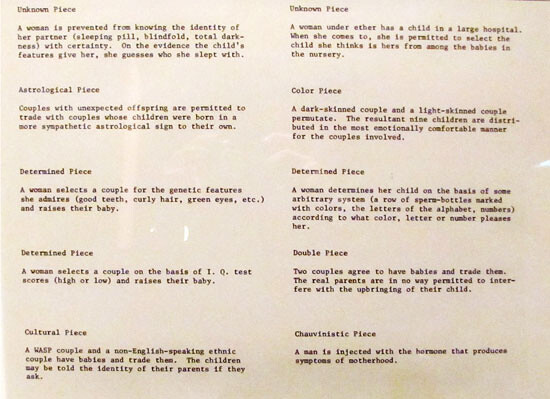

Conceptual Art Arrives
Conceptual Art arrives as a paradoxical supplement, and art-institutional instantiation, of the interaction between these two approaches. By 1970 we were well inside an art movement, as evidenced by the number of books, exhibitions, articles, and so forth, with Idea Art, Konzept Kunst, and so on, in their titles. This includes Lucy Lippard’s exhibitions and the Six Years book, as well as exhibitions such as “45°30’N-73°36’W + Inventory,” presented in Montreal in 1971 by Gary Coward with Arthur Bardo and Bill Vazan.
Common consensus now is that the full-glare moment of art-world and public recognition was the 1970 exhibition “Conceptual Art, Conceptual Aspects,” curated by Donald Karshan at the New York Cultural Center (with Kosuth and Burn as “ghost curators”). Note that the double has already appeared: yes, there is core Conceptual art, but there is also art that has some conceptual qualities (“aspects”), that is, there is also conceptualist art.
But there was, by 1971, a big shift under way within the movement itself, leading to the third element of my theory:
3. The conditions—social, languaged, cultural, and political—of practices (1) and (2) were problematized, as was communicative exchange as such (that is, inquiry became an active engagement in the pragmatic conditions that might generate a defeasible sociality).
Put more simply, if Art & Language’s self-critique was at the core of conceptualism at this time (as in the indexing projects such as Index 01, 1972, at documenta 5), other artists were taking up these analytical procedures and applying them to real-life situations. Obviously, this occurred differently in different places, and differently again for artists in transit between them. Well-known examples are Hans Haacke’s Shapolsky et. al (1971) and Mary Kelly’s Post-Partum Document (1973–9). Less known are Martha Wilson’s Chauvinistic Pieces, 1971: these are an extraordinary application of nominative generalities to life situations so as to bring out the absurd gap between the two, and the power structures built into them. For instance, Unknown Piece has this instruction: “A woman is prevented from knowing the identity of her partner (sleeping pill, blindfold, total darkness) with certainty. On the evidence the child’s features give her, she guesses who she slept with.” Determined Piece: “A woman selects a couple for the genetic features she admires (good teeth, curly hair, green eyes, etc.) and raises their baby.” Chauvinistic Piece: “A man is injected with the hormones that produce symptoms of motherhood.” It is as if the 1960s, far from being the moment of free love and so forth, was already organized along the lines of Plato’s Republic.16
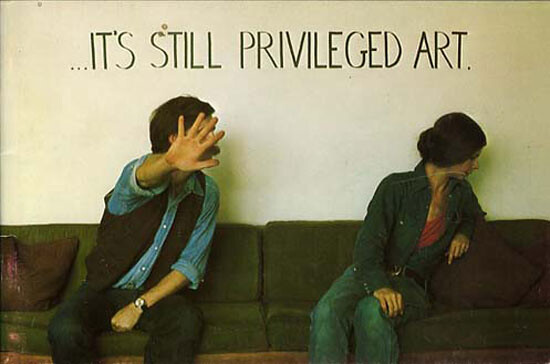

Transformations occurred within Art & Language, such that its work joined the third sense I have identified. We realized that our extreme adoption of avant-garde strategies was belated, was infused with a sense that we were being avant-gardists after the death of the form. When Allan Kaprow invited me to lecture at CalArts in 1974, he introduced me as “a living dinosaur, an actual avant-gardist.” Thus we moved to embed our practice in the world, starting with ourselves as actors in the art world.17Blurting in A&L (1973) enables readers to enter a conversation and shape it according to their own preferences; Draft for an Anti-Textbook was a 1974 issue of Art-Language that, among other things, took on provincialism in theory; the exhibitions recorded in Art & Language Australia (1975) did so in practice. The three issues of The Fox (1975–6) constitute the group’s most direct assault on the modernist art world. Ian Burn, Nigel Lendon, and I continued this kind of work in Australia when we returned in the mid-1970s, creating an Art & Working Life movement that persists, in a dispersed fashion, to this day.18 Karl Beveridge and Carole Condé’s comic book It’s Still Privileged Art (1976) was based on Maoist practices of constant self-criticism; the Cultural Revolution comes to the New York art world (we saw a lot of these publications in Chinatown).19 I cannot overstress how important critical conceptualism was for the success of work with trade unions and dissident groups in Australia, Toronto, and elsewhere, and how important this particular commitment to consequence remains for subsequent artists of major caliber (such as Jeff Wall and Allan Sekula), as well as for the hundreds of artist collectives that operate all over the world today with this kind of work as part of their inspirational armory.
Conceptualism Already Redux
Now we arrive at the moment after conceptual art, when “conceptualism” appeared as a term in art discourse. Let us examine it from the point of view of the “theory” I have advanced. The key question will be: are we looking at delayed, or belated, or simply particular, peculiar, and other instances of (1) and (2), a local instance of (3), or is this a fourth sense/term/proposition that must be added to the three so far advanced? My answer will be: yes, no, and yes. One and three ideas, non-contemporaneously and contemporaneously, again. I will explore two cases among the many that arose during these years all over the world.
When Boris Groys coined the term “Moscow Romantic Conceptualism” in 1979, he created a verbal artifact that, I believe, attempted to stand at the same kind of critical (ironic yet implicated) distance from international art discourse, and to its own circumstances of production, as he understood the art itself to be. Writing for readers in Russia (knowing that the circulation of his essay there would be clandestine), and for readers in France, who would presumably read it in English, he wanted to draw attention to how deeply embedded this kind of work was in the specific conditions of what it was to make “apartment art” in Moscow, to the awkward, embattled, ironic inwardness of the work (the artists wished to be anywhere but Moscow, but could not be). Similarly, in a society that ignored or repressed them, and was condemned to the skeptical resignation that filled “the Russian soul” like a lead balloon, the artists could only dream of being regarded as paragons of heightened subjectivism like the German and English Romantics. But dream they did—and why not; dreams are cheap. Finally, their art stood at a deliberate distance from the concerns and character of US and European Conceptual art as we have discussed it. Thus, by “Conceptualism” Groys meant that this art was like such art in its self-reflective character, but in reverse, precisely in its deliberate effort to be intuitive, allusive, affective—that is, nonconceptual. In other words, each term within Groys’s label had its opposite built into it—thus its acuity, as an art critical artifact.
In the 1979 issue of A-YA, the English translation of Groys’s essay had some oddities. It offers two definitions, the first of which states that “The word ‘conceptualism’ may be understood in the narrower sense as designating a specific artistic movement clearly limited to place, time and origin.”20 The revised translation in History Becomes Form adds the phrase “and limited to a specific number of practitioners” to this sentence.21 The reference here is to US and European Conceptual art. The second definition is this:
Or, it may be interpreted more broadly, by referring to any attempt to withdraw from considering art works as material objects intended for contemplation and aesthetic evaluation. Instead, it could encourage solicitation and formation of the conditions that determine the viewer’s perception of the work of art, the process of its inception by the artist, its relation to factors in the environment, and its temporal status.22
The recent translation changes the last two ideas to “its positioning in a certain context, and its historical status.” This ties the description more closely to the Moscow group, and to art concerned with art, but it remains rather general.
“Romantic” got dropped from the term in the years after 1989, when this art (as distinct from the modernist, informal, protest art) began to be read as a prefiguration of the collapse of the Soviet system, and as the basis for all subsequent art in Russia of any seriousness. Groys’s pragmatism enables us to see other artists carrying on the spirit of the Moscow Romantic Conceptualists, albeit in equally unorthodox ways. His key exemplars are Andrei Monastyrsky and the Collective Actions group, which dedicated itself to actions that heightened the specificity of everyday life while remaining, at the same time, scarcely distinguishable from it. The Medical Hermeneutics group made “work” from speculation about whether such actions were art or life.
To me, the real parallels in work such as Ilya Kabakov’s Answers of the Experimental Group (1971)—the originary moment of “Moscow Conceptualism,” according to Matthew Jesse Jackson—are with the interrogatory nature of the late 1950s / early 1960s work of Johns, Rauschenberg, and Warhol, which I have suggested is conceptual in the broad sense of the term.23 More precisely, it accords with my first proposition above, that conceptualism was, at its various beginnings, a set of practices for interrogating what it was for perceiving subjects and perceived objects to be in the world, and the minimal situations in which art might be possible. Moscow Conceptualism is not consonant with my second proposition, exemplified by the Adornoesque negative criticality of Kosuth et al., yet it is in quite specific ways an instance of the third. The fact that it was produced after the institutionalization of Conceptual art means that one element in its makeup was a refusal of such art, a sense that adopting its modes would be irrelevant to local concerns and to local audiences. I do not see any artist working in the Soviet sphere as producing classical Conceptual art—indeed, there is no reason to expect that any one would wish to do so. On the other hand, groups such as Collective Actions and Medical Hermeneutics and a number of individual artists were, in the 1970s and 1980s, making art in a context where they were aware of conceptual art before and during Conceptual art, and were contemporaries with conceptualist art after it, so they made their choices accordingly. Again, the work emerges out of the concerns expressed in my third proposition. If parallels have to be found, it is closest to Fluxus in Europe.
In his otherwise excellent survey, Jackson never questions the term “Moscow Conceptualism.” There are, however, extensive discussions of it, along with a range of other terms that were in use at the time and that have been developed since, in the new book edited by Alla Rosenfeld, Moscow Conceptualism in Context.24 The most detailed account is “The Banner Without a Slogan: Definitions and Sources of Moscow Conceptualism” by Marek Bartelik, who concludes a useful survey by warning us against the danger of those who would manage the politics of memory:
It is crucial, therefore, to assure that the history of the movement not be reduced to a few textbook names of artists at the expense of others who for some reason or another fell out of the picture. In other words, our history of Moscow Conceptualism should be inclusive rather than exclusive of as many artists as possible. After all, it was Moscow Conceptualism’s ethereal, dispersed, and fragmentary nature—as opposed to the official, solid, and permanent nature of Socialist Realism and its correlates—that helped its development and survival for more than twenty years, and that constitutes its unique value for today’s audiences in both Russia and the West.25
This is well meant, but it does not tackle the point about consequence. A similar politics of hope drove the curatorial project that has been most influential in defining the term “conceptualism” in art discourse in recent decades. In their foreword to Global Conceptualism: Points of Origin, 1950s–1980s (New York: Queens Museum of Art, 1999), Luis Camnitzer, Jane Farver, and Rachel Weiss distinguish two periods, “two relatively distinct waves of activity”: the late 1950s to around 1973, during which time worldwide political changes led artists to call into question the underlying ideas of art and its institutional systems, and the mid-1970s to the end of the 1980s, when artists mostly outside Euro-America abandoned formalist or traditional art practices for conceptualist art.26 As they write:
It is important to delineate a clear distinction between conceptual art as a term used to denote an essentially formalist practice developed in the wake of minimalism, and conceptualism, which broke decisively from the historical dependence of art upon physical form and its visual appreciation. Conceptualism was a broader attitudinal expression that summarized a wide array of works and practices which, in radically reducing the role of the art object, reimagined the possibilities of art vis-à-vis the social, political and economic realities within which it was being made. Its informality and affinity for collectivity made conceptualism attractive to those artists who yearned for a more direct engagement with the public during those intense, transformative periods. For them, the de-emphasis—or the dematerialization—of the object allowed the artistic energies to move from the object to the conduct of art.27
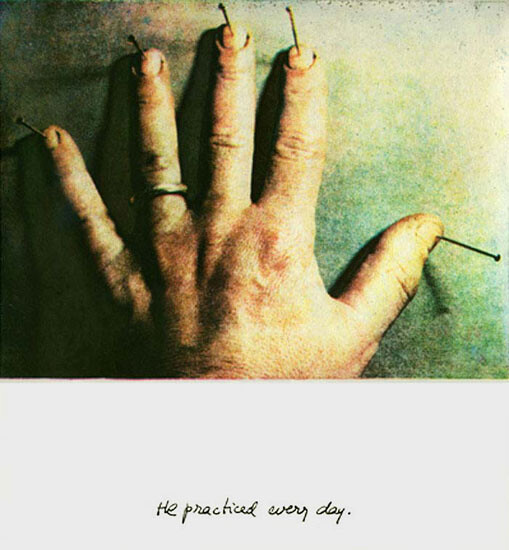

The implication is that Euro-American style Conceptual art—even as it came to dominate understandings of what counted as conceptual art—amounted to little more than an essentially formalist critique of minimalism. It was an internal art world style change, whereas conceptualist tendencies elsewhere were always broader, more social and political, and became more so as time went on, eventually eclipsing Euro-American tendencies. Works by Camnitzer, such as his Uruguayan Torture Series (1983–4), give some substance to this view.28 While in general I support this openness, especially as we come closer to the present, we must also be watchful that it does not lapse into a kind of reverse reductivism, one that downplays the internal complexities of Euro-American conceptualism and fails to see its progressive transformations, as suggested by my propositions.
The “Global Conceptualism” curators did espouse a critical geopolitics, noting that the changes within conceptualism occurred most significantly on local levels: “the reading of ‘globalism’ that informs this project is a highly differentiated one, in which localities are linked in crucial ways but not subsumed into a homogenized set of circumstances and responses to them. We mean to denote a multicentered map with various points of origin in which local events are crucial determinants.”29 A number of interesting alternative terms appear in the essays, including “Non-object art,” applied to Hélio Oiticica’s parangolés by Brazilian critic Ferreira Gullar in 1959, and “Post-Object Art,” used by aesthetician and sculptor Donald Brook in Sydney in 1968–9. Curators from all over the world were invited to mount mini-exhibitions of art that would meet this understanding of conceptualism. Margarita Tupitsyn argued that in Russia two tendencies—Kabakovian “stylelessness” and Sots Art (Soviet kitsch into high art)—combined to generate a word-image interplay that was uniquely inflected by its peculiarly Soviet context.30
In some of these situations, it may be that “conceptualism” works as a substitute for what I believe the artists involved were—and remain—primarily concerned about: as Reiko Tomii demonstrates in the case of Japan, they sought recognition of their contemporaneity with the Euro-American artists, and even of their precedence in some cases.31 Given that Conceptual art was the most radical, avant-garde, innovative, and consequential-seeming art of the time and has retained much of that aura since, they wanted to expand its definition to include themselves. On the most obvious level of simple fairness, they want to be seen to have been contemporary. This, I suggest, is actually more important to many of those involved than whether or not their art was, or may now be seen to be, conceptual.
From the perspective of the broad historical account that I am developing in my work at the moment, I see these artists as wishing to be acknowledged as equally important innovators within the worldwide shift from late modern to contemporary art.32 In this sense, they are right to seek such acknowledgment. However, like all claims for consequence, it comes with responsibilities.
Contemporaneity
Mel Ramsden described Conceptual art as “like Modernism’s nervous breakdown.”33 A more parochial way of putting it was “Clement Greenberg’s nightmare” (although that had already happened, when Frank Stella showed his black paintings in 1959, and MoMA exhibited them soon after). Michael Fried’s nightmare, then. From my perspective, these intense disputations are all indicative of the moment in which late modern art became contemporary, that is, it was obliged to change fundamentally as part of the general transformation of modernity into our current condition, in which the contemporaneity of difference, not our declining modernity or passé postmodernity, is definitive of experience.
Clearly, there is a spirit of openhandedness in post-conceptual art uses of the term “Conceptualism.” We can now endow it with a capital letter because it has grown in scale from its initial designation of an avant-garde grouping, or various groups in various places, and has evolved in two further phases. It became something like a movement, on par with and evolving at the same time as Minimalism. Thus the sense it has in a book such as Tony Godfrey’s Conceptual Art.34 Beyond that, it has in recent years spread to become a tendency, a resonance within art practice that is nearly ubiquitous. Thus the widespread use of terms such as “postconceptual” as a prefix to painting such as that of Gerhard Richter and photography such as that of Andreas Gursky. And the appeal for inclusiveness cited earlier, as well as the nearly universal use of “conceptual” for any art based on any kind of idea (as distinct from it issuing from instinct, taste, or the materials).
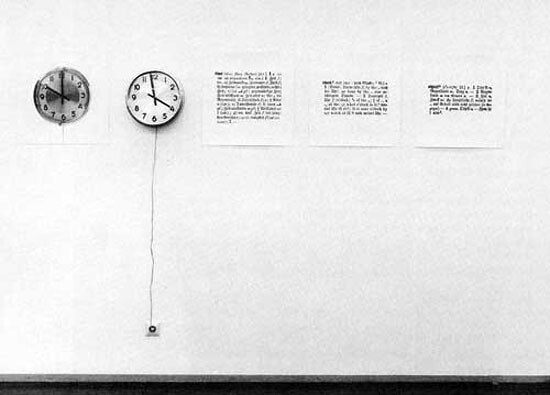

But inclusiveness, however desirable, does not mean that everyone was, and is, making the same kind of art, nor that they did so, or are doing so now, with the same degree of consequence. If we want to address critically the contemporary ubiquity of the idea that “After Conceptual art, all art is conceptual” (of course echoing Kosuth on Duchamp in 1969, but in a bland, generalizing fashion), we could do worse than contrast a piece by Kosuth, One and Five (Clock) (1965) (in the Tate collection, London), with a celebrated work by Felix Gonzalez-Torres, “Untitled” (Perfect Lovers) (1987–90). We can see in retrospect that Kosuth is searching for his “Art as Idea” format; he had not quite settled on the absolute tautology that drives it in the classic three-part presentations with which we are familiar. Instead, he lines up a photograph, an object, and a set of definitions that display the conceptual architecture of clock-time, arraying it across its pictorial, mechanical, and linguistic aspects. One thing after another, Judd-like, in a row, minimally. Five ways of shaping time are displayed. The printed definition of “time” is front and center, and is flanked on one side by an actual clock ticking time along and away, and by a photograph that will forever freeze the time shown on the clock it recorded but which will, being printed on paper, itself fade. On the other side are printed definitions of “mechanization” and of “object,” concepts that elaborate the contexts of both the clock and the camera. The idea world of clock-time is being probed, its relevant concepts being assembled almost spatially. This is conceptualism just before it becomes Conceptual art, the quest before the rigor sets in.
If, in regard to Pop art and Euro-American conceptualism, we are, as Boris Groys has remarked, looking at art that presumes a society built on freedom of choice (however apparent, spectacularized, and ultimately consumerist it may be), for the Moscow Romantic Conceptualists the very idea of having a choice was but a dream (yet impossibility is precisely what occasions dreams). This, too, but very differently, is the point of “Untitled” (Perfect Lovers). The only “choice” for lovers in a time of AIDS was about the manner in which they died—including whether they died together, as comrades of a dying time.
Consequence counts differently at different times, in different places. This, above all, is what we need to keep in mind when we puzzle over what was at stake in art when it was made, and what we need to look for in art that is being made now.
Cited on a file card from the catalogue/exhibition by Gary Coward with Arthur Bardo and Bill Vazan, “45°30’N-73°36’W + Inventory ,” Williams Art Gallery, Montreal, 1971.
Simon Blackburn, ed., The Oxford Dictionary of Philosophy (Oxford: Oxford University Press, 1996.) Oxford Reference Online. Oxford University Press, posted April 8, 2008.
Terry Smith, “Peripheries in Motion: Conceptualism and Conceptual Art in Australia and New Zealand,” in Luis Camnitzer, Jane Farver, and Rachel Weiss, eds., Global Conceptualism: Points of Origin, 1950s–1980s (New York: Queens Museum of Art, 1999), 87–95.
Ian Burn, “Conceptual Art as Art,” Art and Australia (September 1970): 167–70.
During the 1990s, Burn became acutely aware of what he saw as the growing disjunction between the histories of art written by art historians and what he saw as the historical work, on both art and history, being undertaken in certain works of art: “While any image or object can be fitted into many historical discourses, it cannot be at the expense of the historical discourse within the image itself.” (Ian Burn, “Is Art History Any Use to Artists?,” in Ian Burn, Dialogue: Writings in Art History (Sydney: Allen & Unwin, 1991), 6.) To Burn, artists created that discourse less as picturing of it (as if it were a parade occurring at a representable distance), more in the way they composed their works, in the disposition of elements internal to each work. Sidney Nolan and Fernand Léger were prominent examples: in one of his essays, Burn showed that Nolan used some compositional ideas of Léger’s not to create a local modernism, nor to modernize his own art by imitation, but to negotiate a reconception of what landscape might mean in Australian art and history. “Sidney Nolan: Landscape and Modern Life,” in Burn, Dialogue, 67–85.
Conversation, New York, March 27, 2011.
An observation made by Boris Groys in a seminar at the Courtauld Institute, University of London, March 9, 2011.
“Before the Warhol canvases we are trapped in ghastly embarrassment. This sense of arbitrary coloring, the nearly obliterated image and the persistently intrusive feeling. Somewhere in the image there is a proposition. It is unclear.” David Antin, “Warhol: The Silver Tenement,” Art News (Summer 1966): 58. Cited by Leo Steinberg, see Harrison & Wood , 953.
I first published these propositions, under the heading “A Theory of Conceptualism” in “Conceptual Art in Transit,” chapter 6 of Transformations in Australian Art, volume 2, The Twentieth Century—Modernism and Aboriginality (Sydney: Craftsman House, 2002), 127. They may be found in a nascent form, but applied to the Art & Language group only, in my essay “Art and Art & Language,” Artforum XII, no. 6 (February 1974): 49–52.
“Concept Art” is first of all an art of which the material is concepts, as the material of e.g. music is sound. Since concepts are closely bound up with language, concept art is the kind of art of which the material is language.” Henry Flynt, “Concept Art,” 1961, in La Monte Young ed., An Anthology (New York: George Maciunas and Jackson MacLow, 1962).
Morris is just one among many artists whose breakthrough work during the 1960s and 1970s has led to a practice that is at once innovative, reactive to the innovations of younger artists, and retrospective with respect to itself and the innovations of contemporaries past and present. This is a (remodernist) resonance within contemporary art that calls for careful analysis and cautious synopsis.
“For the artist… is concerned only with the way (1) in which art is capable of conceptual growth and (2) how his propositions are logically capable of following that growth.” Joseph Kosuth, “Art After Philosophy,” Studio International 178, nos. 915–17 (1969); in Joseph Kosuth, Art After Philosophy and After: Collected Writings, 1966–1990 (Cambridge, Mass.: MIT Press, 1991), 20. It is interesting that his illustrations of such propositions include this: “If Pollock is important it is because he painted on loose canvas horizontally to the floor,” not because he hung them on the wall subsequently, and even less due to his notions of “self-expression.” Ibid., 21. University of Pittsburgh graduate student Robert Bailey remarks that Kosuth’s statement could also be taken to mean that after Duchamp drew attention to the conceptual core of consequential art, all art of consequence made at any time anywhere is ipso facto conceptual. This is an idea that unleashes a quest of reinterpretation of potentially immense proportions.
Sol LeWitt, “Paragraphs on Conceptual Art,” Artforum V, no. 10 (Summer 1967): 79–83.
Sol LeWitt, “Sentences on Conceptual Art,” Art-Language 1, no. 1 (May 1969): 11–3. Five versions in manuscript are reproduced in Conceptual Art in the Netherlands and Belgium 1965–1975, ed. Suzanne Héman, Jurie Poot, and Hripsimé Visser (Rotterdam: NAi Publishers for the Stedelijk Museum Amsterdam), 48–83.
Among Canadian artists working in New York at the time, Michael Snow’s Authorization (1969) gets close to this, but the mirror makes it not tautological: it is at least partly about not being able to see one’s whole reflection, and is thus partly consonant with Warhol’s filmmaking. Nor should we forget the obvious fact that it is also a real metaphor for the process of being “authorized”—recorded by authority, as in having a passport photograph taken. Snow’s work Red to the Fifth is tautological: it is a demonstration piece that leaves nothing dangling—rare in Snow’s art, to my knowledge.
A similar set of instructions with slightly different wording is cited in Lucy Lippard, Six Years: The dematerialization of the art object from 1966 to 1972 (New York: Praeger, 1973), 227.
See Terry Smith, “Art and Art & Language,” Artforum XII, no. 6 (February 1974): 49–52.
See Sandy Kirby, ed., Ian Burn, Art: Critical, Political (Nepean, Australia: University of Western Sydney, 1996).
See Bruce Barber, ed., Condé and Beveridge: Class Works (Halifax, Nova Scotia: The Press of the Nova Scotia College of Art and Design, 2008).
Boris Groys, “Moscow Romantic Conceptualism,” A-YA, no. 1 (1979): 1.
Boris Groys, History Becomes Form: Moscow Conceptualism (Cambridge, Mass.: MIT Press, 2010), 35.
A-YA, no. 1 (1979): 1.
Matthew Jesse Jackson, The Experimental Group: Ilya Kabakov, Moscow Conceptualism, Soviet Avant-Gardes (Chicago: University of Chicago Press, 2010), 110.
Alla Rosenfeld, Moscow Conceptualism in Context (Munich: Prestel for the Zimmerli Art Museum at Rutgers University, 2011).
Marek Bartelik, “The Banner Without a Slogan: Definitions and Sources of Moscow Conceptualism,” in Rosenfeld, Moscow Conceptualism in Context, 16.
Camnitzer, Farver, and Weiss, Global Conceptualism, vii.
Camnitzer, Farver, and Weiss, Global Conceptualism, viii.
The Museo del Barrio show could have done better in this regard, but the catalogue is comprehensive. See Hans-Michael Herzog and Katrin Steffen, Luis Camnitzer (Ostfildern, Germany: Hatje-Cantz for Daros Museum, Zurich, 2010).
Camnitzer, Farver, and Weiss, Global Conceptualism, vii.
Margarita Tupitsyn, “About Early Soviet Conceptualism,” in Camnitzer, Farver, and Weiss, Global Conceptualism, 98–107.
Reiko Tomii, “Historicizing ‘Contemporary Art’: Some Discursive Practices in Gendai Bijutsu in Japan,” positions 12:3 (2004): 611–41.
Cited in Charles Harrison, Conceptual Art and Painting: Further Essays on Art & Language (Cambridge, Mass.: MIT Press, 2001), 27.
See Terry Smith, Contemporary Art: World Currents (London: Laurence King; Upper Saddle River, NJ: Pearson/Prentice Hall, 2011).
Tony Godfrey, Conceptual Art (London: Phaidon, 1998). The most comprehensive compendium, unmatched in its coverage of Central and Eastern European work in particular but global in its reach, is Misko Suvakovic, Konceptualna Umetnost (Novi Sad, Serbia: Muzej Savremene Umetnosti Vojvodine, 2007).
Category
These remarks combine elements from three recent lectures. The first was delivered on November 27, 2010, at the conference organized by Barbara Fischer, director of the Justina M. Barnicke Gallery, University of Toronto, in association with the exhibition “Traffic: Conceptualism in Canada,” shown at the University of Toronto Galleries during the preceding months. The second, dedicated to the memory of Charles Harrison, was delivered at the Courtauld Institute of Art, University of London, on March 8, 2011, as part of a series on Global Conceptualism organized by Sarah Wilson and Boris Groys. The third was presented on April 14, 2011, as part of a conference titled “Revisiting Conceptual Art: The Russian Case in an International Context,” convened by Boris Groys and organized by the Stella Art Foundation, Moscow. I would like to thank all those concerned.
